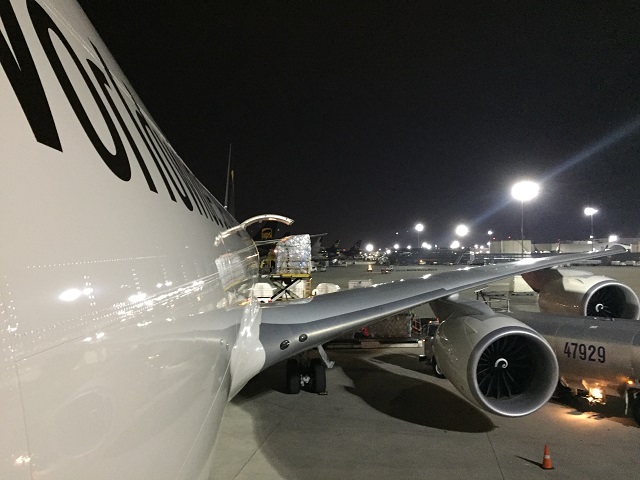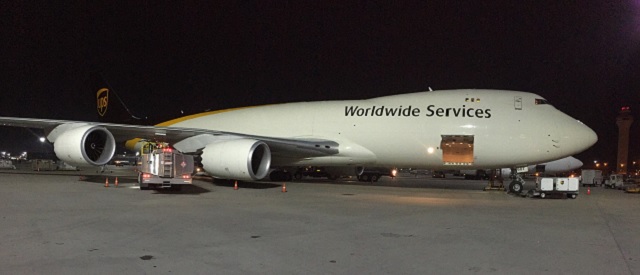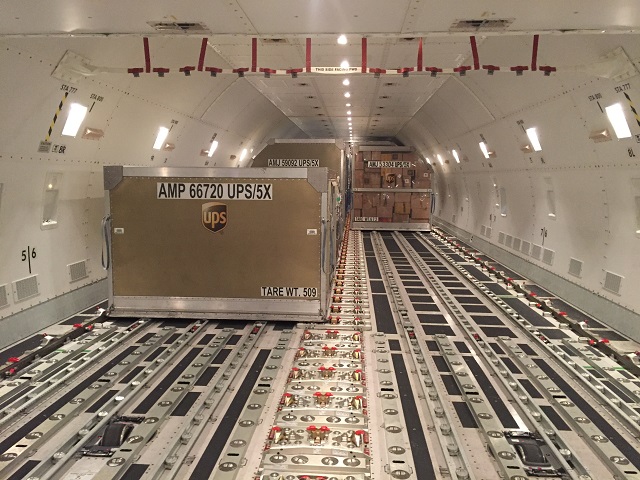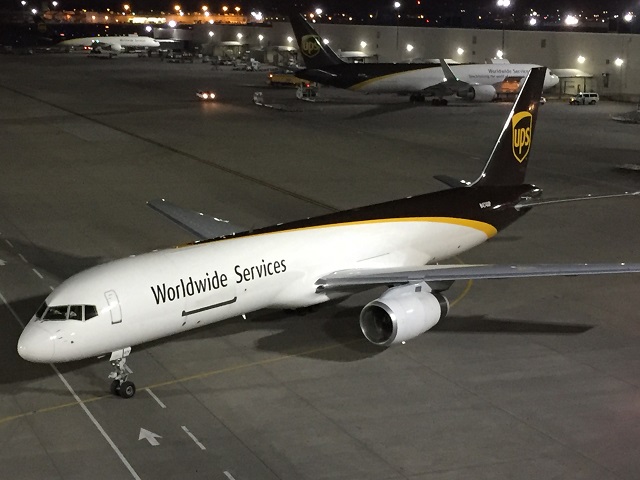In the early hours of 1 February, a gleaming white-and-brown Boeing 747 touched down in Louisville, Kentucky, and taxied to a stand.
Arriving from Anchorage, Alaska, the aircraft was one among a hundred UPS freighters that peppered the runways, taxiways and apron at Louisville that clear night, but this behemoth stood out.
A new 747-8 Freighter. Registration N607UP. Delivered in October 2017, it is more than 5.6m (18ft) longer than UPS's otherwise massive 747-400Fs, and dwarfed nearby MD-11Fs and Airbus A300Fs.
This aircraft, according to UPS, will carry the company into the future.
At a time when passenger airlines cannot seem to retire Boeing 747s fast enough, UPS Airlines thinks that the aircraft, even after all these years, can perform certain missions better than any other freighter.
Also on 1 February, the company disclosed that it had ordered 14 new 747-8 Freighters, saying the aircraft's range and unmatched payload made it ideal for capitalising on surging demand for international shipments.
UPS says the aircraft, which are additional to an earlier order of 14 747-8Fs, will be delivered up to 2022.
The order injected fresh life into Boeing's 747-8 production line amid a broad recovery of the worldwide air cargo market.b
Louisville-based UPS Airlines, a division of Atlanta-based United Parcel Service, says the order reflects "unprecedented growth in demand" for shipments, particularly in the booming area of e-commerce products.
"We are buying the biggest airplanes that we could find," the company says.

Workers unload a UPS 747-8F, registration N607UP, at Louisville on 1 February following a flight from Anchorage
Jon Hemmerdinger/FlightGlobal
UPS's international export shipments – the cargo carried by the company's 747s – jumped 15% year-on-year in 2017, while domestic US next-day air shipments jumped 5.9%, it reported.
The company, which already has four 747-8Fs in service, says no aircraft is better suited to operate heavy-haul routes to cities with constrained airports, such as Hong Kong, Shanghai and Shenzhen, where UPS has a hub. The company primarily serves cities in Asia from Anchorage.
"At those airports, in particular, it makes sense to maximise the capacity of every flight we operate," UPS says.
Powered by GE Aviation GEnx-2B turbofans, the 747-8F can carry 46 cargo containers on two decks. It has maximum payload of nearly 140t and a range of 4,200nm (7,778km). The 747-8F can carry 19% more payload, has 16% more volume and burns 16% less fuel than UPS's CF6-80C2-powered 747-400Fs, the airline says.
"There is no other aircraft in civil aviation that can do that," UPS director of flight training Roger Quinn tells FlightGlobal.
For instance, on a flight from Hong Kong to Anchorage, a distance of about 4,400nm, a 747-8F can carry about 24,040kg (53,000lb) more payload and burn 4,536kg less fuel than a 747-400F, says UPS 747 captain Julio Otero.
"It's a marvellous airplane," he says.

UPS primarily deploys 747-8Fs between Anchorage and Asia
Jon Hemmerdinger/FlightGlobal
While many freight airlines have made twinjets such as the 777F the backbone of their long-haul fleets, UPS chose the 747-8F because it can carry about 25% more payload than the 777, the company says.
"It will allow UPS to fly one larger jet into some cities currently served by two."
George Dimitroff, head of valuations at Flight Ascend Consultancy, a unit of FlightGlobal, notes that the 747-8F "is the highest-payload current-production freighter in existence and has neither any direct competition, nor any replacement. It's also the only nose-loading production freighter".

Using a Boeing-supplied onboard cargo handling system, UPS can unload a 747-8F's 46 cargo containers in about 45min
Jon Hemmerdinger/FlightGlobal
Dimitroff adds: "It is also reasonably new technology that will still be relevant well into next decade, if not beyond."
747 PRODUCTION LIFELINE
Boeing's 747 backlog has dwindled as passenger airlines have switched to twinjets including the 777, 787, A330 and A350.
Indeed, the last remaining US airlines to operate passenger-configured 747s – United Airlines and Delta Air Lines – retired their Jumbos with great fanfare last year.
British Airways, which operates the world's largest 747 passenger fleet with 36 747-400s, is also talking retirement, with plans to pull them from service by February 2024.
Operators worldwide fly 512 747s, including 116 747-8s, 354 747-400s and several dozen older variants, according to Flight Fleets Analyzer.
By comparison, 10 years ago carriers operated 900 747s.
Boeing delivered the first Jumbo, a 747-100, to Pan Am in 1969, and handed over the first of the latest iteration, the 747-8F, to Cargolux in 2011.
Demand has been modest for the newest member of the family, with Boeing having received orders for 150 747-8s and delivered about 124 of the aircraft. The backlog now stands at 26 747-8s.
Passenger airlines have been somewhat standoffish. Three carriers – Air China, Korean Air and Lufthansa – ordered and received 36 747-8 Intercontinentals. Boeing also delivered four VIP-configured aircraft, Flight Fleets Analyzer shows.
The remaining roughly 100 aircraft are freighters, with carriers including AirBridgeCargo, Atlas Air, Cargolux, Cathay Pacific, Korean Air, Nippon Cargo Airlines and Polar Air Cargo Worldwide operating the largest 747-8F fleets.
As demand slowed, Boeing several years ago cut 747-8 production to six aircraft annually.
The backlog had slipped to just 15 aircraft by October 2016, when UPS announced orders for 14 747-8Fs, singlehandedly extended Boeing's 747-8 production until late 2019.
But Boeing's backlog started sliding again, to about a dozen aircraft, including 10 for UPS, at the end of January, according to Flight Fleets Analyzer.
UPS came through again, announcing on 1 February, 30 years to the day since UPS founded its air arm UPS Airlines, that it had converted 14 747-8F options into firm orders.
The order likewise handed Boeing more breathing room, extending deliveries until the end of 2022.
Flight Ascend Consultancy's Dimitroff thinks those extra few years may be enough for Boeing to secure more orders before running the backlog dry.
"We believe the UPS order has nicely extended production to a point where the rest of the market will be ready to place additional orders for the type," he says.
He bases that prediction partly on the recent surge in demand for air shipments, particularly for e-commerce.
"With the growth of e-commerce into and out of China, we suspect a lot of the local operators will want to start their own long-haul services to the Americas, Australia and Europe," Dimitroff says.
The best aircraft for such routes are 747-8Fs, 777Fs and 747-400Fs. But few 747-400Fs are available – airlines snapped up those that were parked as the freight market boomed in 2017, he says.
Air freight demand surged 9% year-on-year in 2017, the greatest gain since 2010, according to IATA's 2017 Air Freight Market Analyses.
Growth reflected strength of the worldwide manufacturing industry and demand for manufacturing exports, the report says. IATA predicts that gains will continue in 2018, but at a more modest pace of around 4.5% year-on-year.
A 2018 Boeing presentation cites figures estimating that global retail e-commerce sales will increase by an average of 19.2% annually until 2021, and that China's e-commerce market will, by 2020, eclipse the combined e-commerce markets of France, Germany, Japan, the UK and the USA.
Boeing predicts that airlines will require 2,480 more air freighters in the next 20 years, including an estimated 920 new aircraft and 1,560 passenger-to-freighter conversions.
The 920 new aircraft figure includes 490 large freighters such as 747s and 777s, and 430 medium freighters such as 767s and Airbus A330s, Boeing says.
The US airframer currently holds orders for 26 747-8Fs, 60 767-300Fs and 30 777Fs, plus passenger-to-freighter conversion orders or commitments for some 36 767BCFs and about 60 737BCFs, Boeing says.
Although UPS has placed the only recent 747 order, others have expressed interest.
William Flynn, chief executive of Atlas Air Worldwide Holdings, tells FlightGlobal: "Through its loading capacity of up to 140t and its improved fuel efficiency compared to earlier 747 models, [the 747-8F] is an exceptional aircraft on key long-haul international trade lanes. The 747 platform is very well positioned for serving the growing e-commerce and express markets, where the need for the highest-volumetric capacity is critical."
Atlas subsidiaries Atlas Air and Polar Air operate 10 747-8Fs, Flight Fleets Analyzer shows.
Flynn notes that the 747-8F and 747-400F are the only aircraft with nose cargo doors, enabling Atlas to carry outsized cargo.
While he does not say whether Atlas intends to buy more 747-8Fs, Flynn has previously suggested that it will.
"I do believe we eventually want more -8s, whether they are ordered new or whether we get them from the market," he told FlightGlobal last year.
Flynn also called the 747-8F's economics "very competitive" with the 777F's when oil prices are below $80 per barrel, which they currently are.
Dimitroff also sees potential for new orders, particularly if Boeing can reduce the type's "somewhat high price tag".
He says: "We believe that there are numerous operators out there… who would be willing to place orders if Boeing is able to price it more attractively, which we think they will be able to start doing once development costs are written down."
FLEET CASCADE
Like its existing 747-400Fs, UPS plans primarily to deploy 747-8Fs on high-demand international routes, particularly routes to Asia.
The company sees significant growth opportunity in Asia, and last year announced plans to form a joint business with Chinese express delivery company SF Holding, an affiliate of SF Airlines, which operates about 40 freighters split between the 737, 757 and 767 types, Flight Fleets Analyzer shows.
On 6 January, UPS also launched a new route from Louisville to Dubai using a 747-8F. That route – at 6,691nm (12,392km), the furthest nonstop UPS says it has ever operated – is part of a new round-the-world service that continues from Dubai to Shenzhen, Anchorage and back to Louisville.
The route is "made possible by the new 747-8s, which offer greater payload over long range", UPS says.
The company's incoming Jumbos will create a "cascade" through the fleet, freeing other aircraft for new missions.
For instance, 747-8Fs will free 747-400Fs to operate routes currently served by MD-11Fs. Those aircraft can free A300s to serve 767F routes, which can potentially free 757Fs to launch new routes, the company says.

A UPS 757-200F arrives at Louisville on 1 February
Jon Hemmerdinger/FlightGlobal
The 747-8F's commonality with the 747-400F, particularly for maintenance and pilot training, was another factor leading UPS to order more aircraft.
UPS uses both 747 models interchangeably, and 747-400F pilots need only complete a three-day "differences" course to quality for 747-8Fs, UPS says.
The day it announced the 747-8F order, UPS also said it had ordered four new 767-300ERFs, and the company has orders for three passenger-to-freighter converted 767BCFs.
The incoming aircraft will join a fleet that currently stands at 240 aircraft, including 75 757-200Fs, 59 767-300ERFs, 52 A300-600RFs, 37 MD-11Fs, 13 747-400Fs and four 747-8Fs.
UPS's total air payload capacity will jump 30% by 2022, when all outstanding orders for aircraft have joined the fleet, it says.
"We have no plans to retire anything," says UPS's Quinn.
UPS fleet and order book

Source: Cirium Dashboard






















